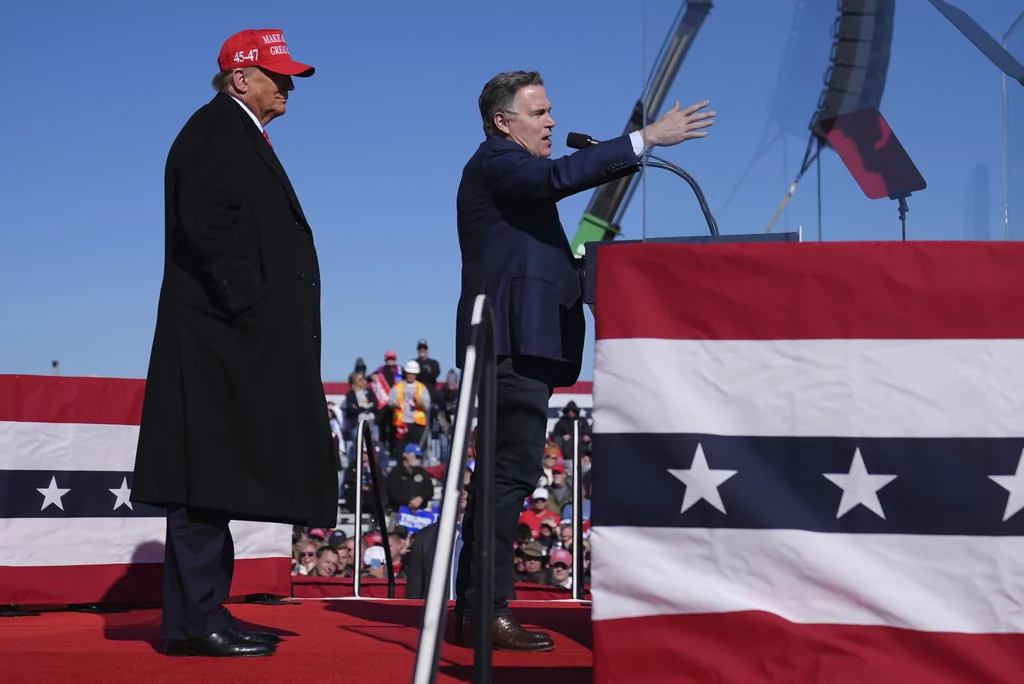There’s a silver lining from the elections for Senate Democrats, despite losing their majority.
Republican Senate hopefuls underperformed the top of the ticket in several battleground states by tens of thousands of votes, giving way to President-elect Donald Trump capturing key victories where voters chose to stick with Democratic senators.
The ticket-splitting has Democrats already eyeing the 2026 midterms, when a backlash to the incumbent administration and the lack of Trump’s coattails could bode well for the majority swinging back to Democrats.
“When this process of counting the votes concludes, Democrats will have won races in multiple states carried by Trump and successfully limited the GOP’s potential gains on their historically favorable map,” said Democratic Senatorial Campaign Committee (DSCC) Communications Director David Bergstein.
DEMOCRATS WEIGH CHANGE IN STRATEGY TO AVOID MIDTERM AND 2028 DEFEATS
Republicans are on track for a 53-47 Senate majority, pending one outstanding race. That’s a four-seat swing from Democrats’ current 51-49 margin. Blue seats in West Virginia, Ohio, Montana, and Pennsylvania flipped red, all states that Trump won.
But the GOP could have expanded their majority to as much as 57-43, had Democrats not stemmed the bleeding by keeping four seats in states where Trump won: Wisconsin, Michigan, Arizona, and Nevada. (The Arizona Senate race remained too close to call but appeared likely to go to Democrats.)
In Pennsylvania, Republican Dave McCormick’s slim 0.6% margin of victory, or roughly 40,000 votes, over Sen. Bob Casey (D-PA) was teetering on the edge of a 0.5% margin that would trigger a mandatory recount. Trump, by comparison, was eclipsing Vice President Kamala Harris with a 2.1%-point margin, or north of 146,000 votes, in the Keystone State that continued to tally ballots into the weekend.
“These results, which defy historical trends, are a stark demonstration of the strength of our candidates, and the unique support they have earned from voters of every political party in a challenging political atmosphere,” Bergstein added.

This cycle’s Senate map was the most favorable to Republicans for the foreseeable future. One could also make the case that rather than Republicans underperforming Trump, Senate Democrats outperformed Harris.
In 2026, Democrats will need to defend only two battleground seats as opposed to this year’s seven. Those will be in Georgia and Michigan with Sens. Raphael Warnock and Gary Peters (D-MI). That allows Democrats to go on offense with seats that were competitive when they were last up in 2020, such as in Maine with Sen. Susan Collins (R-ME), North Carolina with Sen. Thom Tillis (R-NC), Texas with Sen. John Cornyn (R-TX), Alaska with Sen. Dan Sullivan (R-AK), and Montana with Sen. Steve Daines (R-MT), who chaired the Senate GOP campaign arm for 2024.
NAMES SWIRL FOR TRUMP SECOND CABINET AS TRANSITION TEAM MEETS WHITE HOUSE
Down-ballot candidates naturally receive fewer votes. But what’s rarer is voters in a state electing a president and senator from opposing parties.
Democrats insist the Senate results were about candidate quality. Among GOP insiders, some pit Democrats’ ability to buck the red wave on a lack of name ID for Republican challengers from being outspent.
“There is a reason Daines was screaming from the rooftop that Republican candidates needed more money, or they were going to lose winnable races,” said a GOP strategist who works on Senate races, who was granted anonymity. “Republicans surged post-Labor Day, but the pummeling candidates took over the summer due to the resource disadvantage at the candidate level meant a few came up short.”
To compensate for the cash deficits and to conserve vital funds, the National Republican Senatorial Committee relied on so-called “hybrid ads” so the campaign arm could split costs with the candidates and get cheaper ad rates. The tactic irked some candidates and raised questions about the spending strategy of national Republicans.
“Unless you’re a very unique and rare candidate, your first time running statewide you’re not going to be as well-known as the incumbent,” said Doug Heye, a former GOP communications staffer in the House, Senate, Republican National Committee, and George W. Bush administration. “That’s just a political fact of life.”
In some cases, the results suggested that down-ballot Republicans were simply unable to match the enthusiasm that Trump drives to the top of the ticket for reasons beyond name recognition.
In Nevada, for example, Trump was ahead of Harris more than 46,000 votes, or 3.3%. Almost 19,000 voted for “none of the above.” GOP Senate nominee Sam Brown was losing to Sen. Jacky Rosen (D-NV) by about 20,500 votes, or 1.4%, with north of 41,000 voting for “none of the above.”
A Nevada GOP operative disagreed name ID was the culprit, given Brown’s overperformance from the polls and statewide recognition, particularly among Republicans. Brown lost in the 2022 GOP Senate primary to former state Attorney General Adam Laxalt.
Rather, the operative opined that the outcome was part of a broader inability for down-ballot Republicans to capitalize on Trump’s popularity, no matter candidates’ proximities to the former president’s “MAGA” base.
CLICK HERE TO READ MORE FROM THE WASHINGTON EXAMINER
Democratic strategist Hank Sheinkopf, a former adviser to President Bill Clinton and former New York City Mayor Michael Bloomberg, offered a further diverging theory that the level of crossover voting was evidence of weakening national parties.
“People are voting for individuals and not voting for party because, frankly, Republicans stand for Trump — that’s what Republicans are — and Democrats stand for — no one knows what they stand for,” Sheinkopf said. “Where voters have a relationship with the people they’re voting for and feel strongly about them, they vote for them. And where they don’t, they don’t.”
























